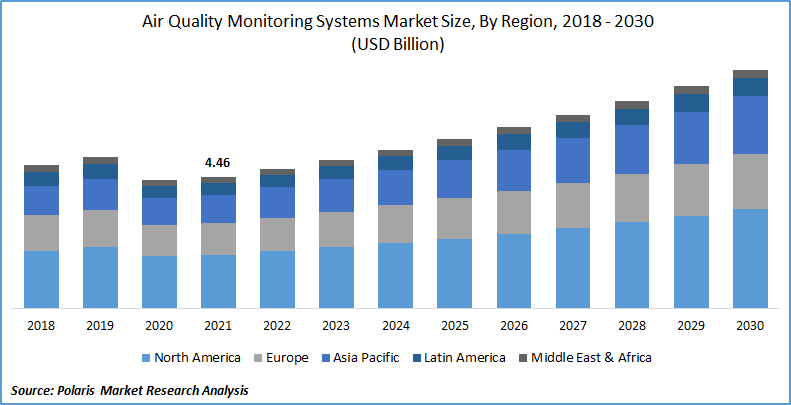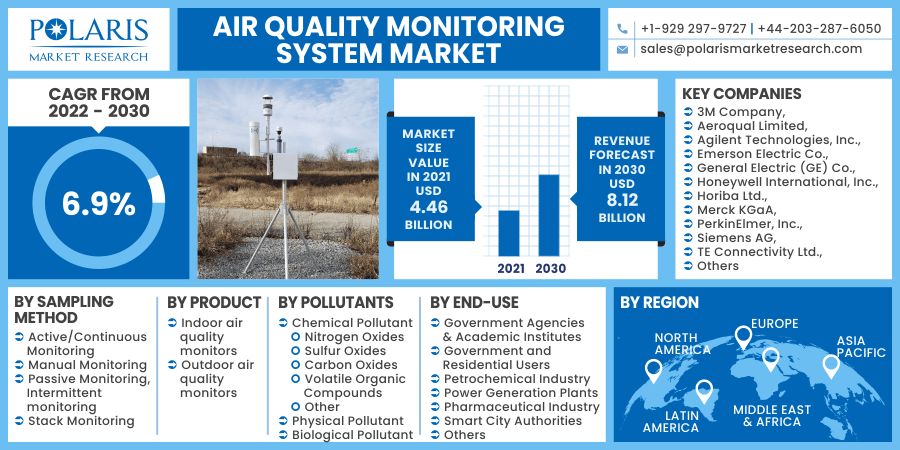
Air Quality Monitoring System Market Share, Size, Trends, Industry Analysis Report, By Product (Indoor air quality monitors, Outdoor air quality monitors); By Sampling Method; By Pollutants (Chemical Pollutant, Physical Pollutant, Biological Pollutant); By End-Use, By Region; Segment Forecast, 2022 - 2030
- Published Date:Jan-2022
- Pages: 101
- Format: PDF
- Report ID: PM2210
- Base Year: 2021
- Historical Data: 2018 - 2020
Report Summary
The global air quality monitoring system market was valued at USD 4.46 billion in 2021 and is expected to grow at a CAGR of 6.9% during the forecast period. The growth in the market is being driven by supportive government regulations for effective weather pollution monitoring and control. For instance, the National Air Quality Monitoring Programme (NAMP) is a nationwide ambient air condition observing program run by the Central Pollution Control Board.

Know more about this report: request for sample pages
The network has 804 working stations serving 344 cities/towns in 28 states and six union territories. Further, the EPA operates several NAAQS-related ambient weather conditions observing system initiatives. The Ambient Air Monitoring Program, which collects national weather condition data on criteria pollutants such as carbon monoxide (CO), nitrogen oxides (NO2 and NO3), ozone (O3), particulate matter (PM) - both particulates with aerodynamic diameters less than 10 micrometers (PM-10) and particulates with aerodynamic diameters less than 2.5 micrometers (PM-2.5), sulfur dioxide (SO2), and volatile organic compounds (VOC).
The program is implemented by the Environmental Protection Agency (EPA) in collaboration with state and local weather pollution control agencies, with EPA oversight and guidance. EPA also maintains several other initiatives that collect local, tribal, state, regional, and national weather conditions. Thus, the governments across the globe offering various programs for weather conditions observing and regulation of weather conditions is the factor propelling the market demand for weather quality monitoring system market.
However, the stringent pollution policies, which require effective measures to control all forms of weather pollutants, data collection, and data surveillance, exacerbate the high costs associated with the purchase and establishment of AQM sensors. As a result, the high installation costs of AQM stations and the premium pricing of the advanced observing system are projected to limit their ideal market expansion during the forecast period.

Know more about this report: request for sample pages
Industry Dynamics
Growth Drivers
The air quality monitoring system market has observed extensive developments in the last few decades supported by various factors such as the rise in weather pollution and the increased awareness of the adverse effect of health. Asthma, diabetes, obstructive pulmonary disease, and cardiovascular diseases have become more prevalent as pollution levels have increased. The growing awareness of the adverse health effects has fueled the market of weather condition observing systems. For instance, the WHO publishes reports for weather conditions observing and their impact on health every year.
The World Health Organization's (WHO) Global Air Quality Guidelines (AQGs) provide compelling evidence of the harm weather pollution causes to human health, even in lower quantities than previously thought. The guidelines offer weather condition system standards to protect people's health by lowering levels of major weather contaminants. WHO has lowered almost all AQGs levels, warning that exceeding the new weather condition guidelines has considerable health risks. On the other hand, Adherence to them could save millions of lives. Air pollution is projected to cause 7 million premature deaths per year and the loss of millions of healthy years of life.
For instance, according to the International Diabetic Federation, diabetic patients are growing at a significant pace. Around 425 million diabetic patients were reported in 2015 globally, whereas these numbers are estimated to grow about 578 million by 2030 and about 700 million by 2045. Thus, the increased cases of chronic disease across the globe due to weather pollution have increased the requirement of weather condition observing system. In addition, along with climate change, weather pollution is one of the most severe environmental hazards to human health. Improving weather conditions can assist with climate change reduction, and lowering emissions will help with the weather conditions.
Report Segmentation
The market is primarily segmented based on product, sampling method, pollutants, end-use, and region.
|
By Sampling Method |
By Product |
By Pollutants |
By End-Use |
By Region |
|
|
|
|
|
Know more about this report: request for sample pages
Insight by Product
Based on the product segment, the indoor air quality monitors segment was the most significant revenue contributor in the global market in 2021 and is expected to retain its dominance over the forecast period. The rapidly increasing installation of AQM stations, initiatives to raise public awareness about the health consequences of indoor air pollution, increasing deployment of electronic home and green-building technologies, and the rising preference for pollution-free indoor environments are all factors contributing to this market's dominant position in the indoor monitor's system segment.
Geographic Overview
In terms of geography, North America had the largest revenue share. The significant player's adoption of various strategies such as partnerships, collaborations, mergers and acquisitions, and product launches also drives the market's growth. For instance, in October 2021, Clarity Movement Co. and 2B Technologies have established a partnership to develop a unique ozone add-on module for Clarity weather quality monitoring system networks.
Besides, India has nine of the world's 10 most polluted cities, according to the World Health Organization's Global Ambient Air Quality Database. The Government of India (GoI) announced the National Clean Air Program (NCAP) in January 2019, which calls for combining manual, continuous, sensor-based, and satellite-based methodologies and systems to improve weather quality monitoring system infrastructure. Environmental and pollution monitors, gas analyzers, sensors, and digital solutions have significant market potential in India's commercial, industrial, and residential sectors. Thus, the launches of weather quality monitoring system programs in emerging countries are propelling the air quality monitoring system market growth during the forecast period.
Competitive Insight
Some of the major market players operating in the global weather quality monitoring system market include 3M Company, Aeroqual Limited, Agilent Technologies, Inc., Emerson Electric Co., General Electric (GE) Co., Honeywell International, Inc., Horiba Ltd., Merck KGaA, PerkinElmer, Inc., Siemens AG, TE Connectivity Ltd., Teledyne Technologies, Inc., Testo, Thermo Fisher Scientific Inc., Tisch Environmenta, and TSI Inc.
Air Quality Monitoring System Market Report Scope
|
Report Attributes |
Details |
|
Market size value in 2021 |
USD 4.46 billion |
|
Revenue forecast in 2030 |
USD 8.12 billion |
|
CAGR |
6.9% from 2022 - 2030 |
|
Base year |
2021 |
|
Historical data |
2018 - 2020 |
|
Forecast period |
2022 - 2030 |
|
Quantitative units |
Revenue in USD million/billion and CAGR from 2022 to 2030 |
|
Segments covered |
By Product, By Sampling Method, By Pollutants, By End-use, By Region |
|
Regional scope |
North America, Europe, Asia Pacific, Latin America, Middle East & Africa |
|
Key Companies |
3M Company, Aeroqual Limited, Agilent Technologies, Inc., Emerson Electric Co., General Electric (GE) Co., Honeywell International, Inc., Horiba Ltd., Merck KGaA, PerkinElmer, Inc., Siemens AG, TE Connectivity Ltd., Teledyne Technologies, Inc., Testo, Thermo Fisher Scientific Inc., Tisch Environmenta, and TSI Inc. |
License and Pricing
Purchase Report Sections
- Regional analysis
- Segmentation analysis
- Industry outlook
- Competitive landscape
Connect with experts
Suggested Report
- Palm Oil Market Share, Size, Trends, Industry Analysis Report, 2022 - 2030
- Medical Holography Market Share, Size, Trends, Industry Analysis Report, 2020-2027
- Asset Integrity Management Market Share, Size, Trends, Industry Analysis Report, 2022 - 2030
- Volumetric Display Market Share, Size, Trends, Industry Analysis Report, 2021 - 2028
- Condensing Unit Market Share, Size, Trends, Industry Analysis Report, 2022 - 2030

